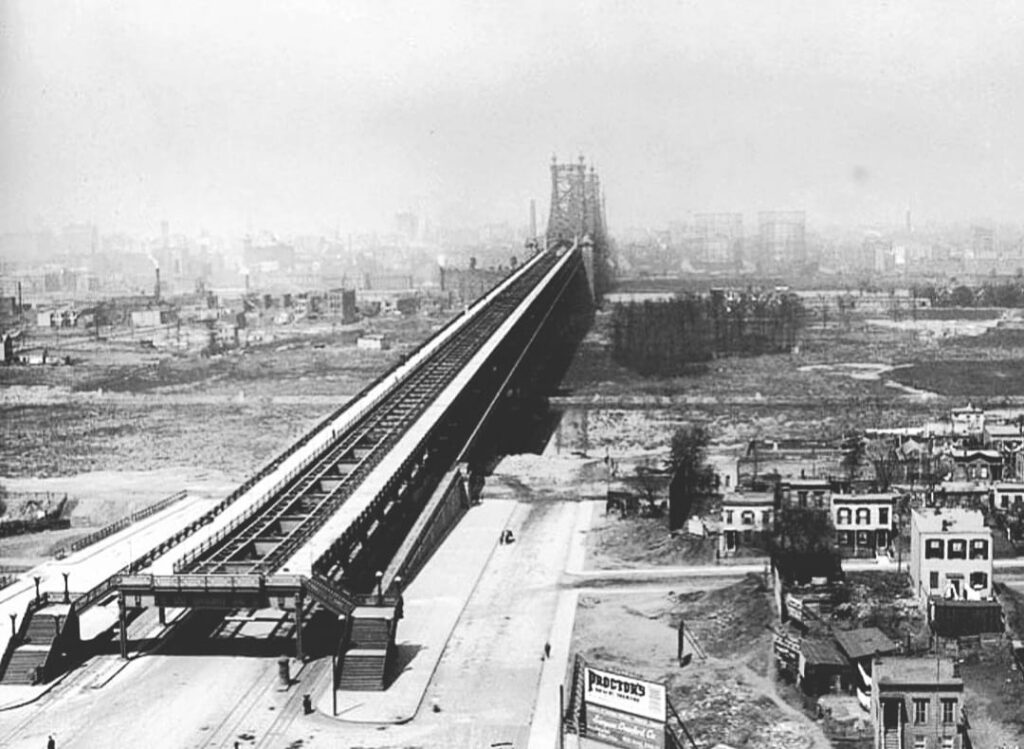
The beginning of the Queensborough Bridge 1907
Queensborough Bridge, the 59th Street Bridge, is an iconic cantilever bridge in New York City. It connects the borough of Queens with Manhattan, spanning the East River. Completed in 1909, it has long been admired for its impressive engineering and classic design. The bridge has an upper and a lower deck, accommodating vehicles, pedestrians, and cyclists.
Fun fact: The bridge was immortalized in Simon & Garfunkel’s song “The 59th Street Bridge Song (Feeling’ Groovy).” It’s an excellent spot for anyone enjoying some fantastic Manhattan skyline views.
The Queensborough Bridge, officially known as the Ed Koch Queensboro Bridge, has a fascinating history:
- Construction and Opening: The bridge was completed in 1909, making it over a century old. It was designed by Gustav Lindenthal and Henry Hornbostel and was the longest cantilever bridge in the United States at the time of its completion.
- Engineering Feat: The bridge initially carried two elevated railway lines, two trolley lines, six carriage lanes, and two pedestrian walkways. Its design was groundbreaking for its era.
- Cultural Significance: The bridge has been featured in various films and songs, including Simon & Garfunkel’s “The 59th Street Bridge Song (Feelin’ Groovy).”
- Renaming: In 2011, the Ed Koch Queensboro Bridge was renamed in honor of the former New York City mayor.
- Landmark Status: It was designated a New York City Landmark in 1974 and added to the National Register of Historic Places in 1978.
It’s a true testament to New York City’s architectural and cultural heritage. Have you ever walked or driven across it?
The construction of the Queensborough Bridge, completed in 1909, was marked by several significant events:
Design Evolution: The original design underwent major revisions when Gustav Lindenthal became Commissioner of Bridges in 1902. His innovative approach eliminated a suspended span between the cantilever arms and introduced massive steel eye bars for the upper chord.
- Engineering Challenges: The collapse of the Quebec Bridge in 1907, another steel cantilever bridge, prompted a thorough review of the Queensborough Bridge’s design. This led to adjustments to ensure its structural integrity.
- Collaboration: The bridge’s construction involved prominent engineers and architects of the time, including Henry Hornbostel, who added decorative elements to enhance its aesthetic appeal.
- Impact on Development: The bridge played a crucial role in shaping midtown Manhattan and Queens, fostering growth and connectivity in these areas.
The bridge’s construction was a testament to early 20th-century engineering and urban planning. It remains a vital part of New York City’s infrastructure.
The construction of the Queensborough Bridge faced several engineering challenges:
- Structural Integrity: Ensuring the bridge’s cantilever design could withstand heavy loads and environmental stresses was a significant challenge. Engineers had to carefully analyze and adjust the design, especially after the collapse of the Quebec Bridge in 1907, which raised concerns about cantilever structures.
- Material Durability: The choice of materials was crucial to ensure the bridge’s longevity. Steel was used extensively, but its properties had to be tested to ensure it could endure the demands of the bridge’s design.
- Urban Constraints: Building a massive structure in the heart of New York City required innovative solutions to manage space and minimize disruption to the surrounding areas.
- Aesthetic Considerations: Balancing functionality with architectural beauty was another challenge. The decorative elements added by Henry Hornbostel were designed to enhance the bridge’s visual appeal.
These challenges highlight the ingenuity and dedication of the engineers and architects who brought Queensborough Bridge to life. It’s a marvel of early 20th-century engineering!
